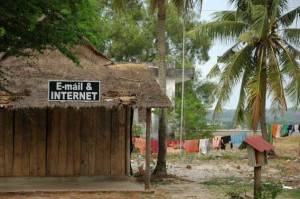For those of us who have gone away for a time to a location where there is no easy internet access available or maybe you decided to just ‘get off the grid’ for a while, either way, when we eventually re-integrate into our old lives, some version of the below tends to happen:
Me: “Siri, wake up! And read out my emails!”
iPhone: “Ok Pete; you currently have 2,546 unread emails”
Me: “By the hammer of Thor!! I’ve only been gone for 2 weeks.. what the hell!?”
Then, imagine that upon closer inspection somewhere between email 1,937 and email 1,939 there may just happen to be one that’s titled: You’ve won $10 million!! – You now have just 1 day to claim your reward, if unclaimed, the entire amount will be donated to the Peruvian Lama Appreciation Society and you’ll miss out, sorry…
DAMN YOU PERUVIAN LAMAS!! Obviously the chances of an email like this actually being legit are only somewhat more likely than a little man in a green top-hat giving me a pot of gold after I find the end of a rainbow… Still the point is that sometimes it’s better to stay connected while on the road!
I was recently travelling around the UK (after somehow avoiding heart failure while eating the food in Scotland) and since I had a number of projects on the go while I was over there I did need to stay online all the time. Given that (for some reason) if you want to just use your phone from home, overseas mobile data is priced like it’s the most valuable commodity in existence (Saffron, diamonds and Unobtanium, the door’s over there, see yourselves out) I obviously needed to find another solution.
So what options does the humble traveller have these days when it comes to keeping their Facebook page updated or twitter status timely?
Below are a few of the ways that are most common among the traveling community for staying online while travelling.
WIFI
Ok Einstein this ones a no brainer. Just wander the streets (if you don’t have access at your hotel/hostel or accommodation that is) looking for the technical salvation that those 3 little curved lines and the dot represent.. find free WIFI at a café or something similar. One of the only good things about Starbucks being basically everywhere is the free broadband internet, it has nothing to do with the coffee. This is generally my go to solution for Internet while abroad but it does really depend on where abouts in the world you are as to its availability (or effectiveness).

Internet cafes
Feel like going old school? Well comb out those sideburns and get ready to rub shoulders with those inevitable 13 year olds and ultra geeks who haven’t yet discovered the joys of women or alcohol. Either way, if you didn’t bring a PC or device along for the ride, then it’s an Internet Café or you could attempt to revive smoke signals.. given some of the experiences I’ve had in internet café’s I might genuinely opt for smoke signals.. always my last resort.
BYO Device & Buy a local Sim
Fairly obvious one here too and this one does lead us neatly into the following option also. Bring your own phone/tablet and buy a local sim card with ¾G access then go nuts. This covers the device itself but what if you wanted to use your beloved Macbook instead? Given that you’ve forced it to cover more miles than Magellan.. Well my eager young conquistador, at the flick of a button, you could make your device into WIFI hotspot and connect your PC like that (can tend to much through your data though).
Portable WIFI (MIFI)
So what do you get when you cross WIFI with the flexibility of using a local 3G network? MIFI, that’s what. Essentially a WIFI network in your pocket that taps into the local 3G network. I’ve used a few of these around the world with some good results. Did that make sense? Here’s an example of an option for internet for tourists in Spain with mifi devices that I found pretty useful at explaining the concept in detail for any luddites out there.
Those are pretty much the basic options of staying online while travelling right there. Obviously the best bet is just using the WIFI at your accommodation; most hostels these days will have free WIFI and generally the less expensive hotels too. For some reason the more expensive hotels still seem to get away with charging for WIFI, no idea who actually pays for it these days but anyway. I’ve also found that 100% of the hosted accommodation I’ve used has had free WIFI (AirBnb, Couch Surfing etc..) so the good news is that staying connected has never been easier as we travel, bad news is, welcome to the world of emails 24/7… (sorry, Peruvian Lama Appreciation Society).


